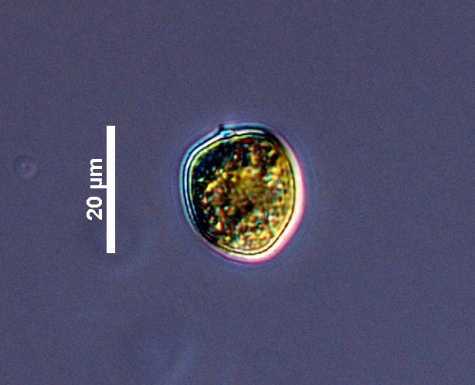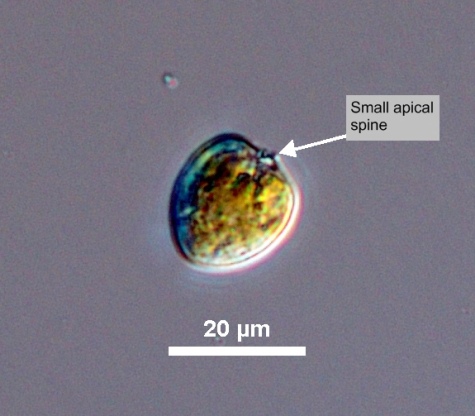



|
Synonym(s)
Prorocentrum triangulatum Martin 1929
Exuviaella marie-lebouriae Parke and Ballantine 1957
Prorocentrum cordiformis Bursa 1959
Prorocentrum marie-lebouriae (Parke and Ballantine 1957) Loeblich III 1970
Exuviaella minima Pavillard 1916
(Smithsonian 2011, Horner 2002)
Classification
(Guiry and Guiry 2011)
Lifestyle
Binary fission
A form of asexual reproduction where one cell divides into two identical cells. All prokaryotes and some eukaryotes reproduce in this manner. Compare with mitosis, where the nucleus must also divide, adding an extra step to the process.
binary fission (Smithsonian 2011).Description
Spine
In some diatoms, "closed or solid structures projecting from the cell wall;" in dinoflagellates, solid projections that usually taper to a point.
spines (difficult to see in CloseLM (light microscopy)
"Using a microscope in which a beam of light passes through optical lenses to view an image of the specimen" (MCM LTER 2010).
LM; Kimor et al. 1985). It has many golden-brown chloroplasts and one large ClosePyrenoid
Any of various protein granules that can be found in the chloroplast of some algae species. It is associated with the production of starch.
pyrenoid (Smithsonian 2011). It has two flagella with numerous pores on them (Red-Tide 2011). It moves quickly in the water (Kimor et al. 1985).Measurements
Width: 10 - 15 μm
Similar species
Harmful effects
Habitat
Distribution
It is a Close
Cosmopolitan
Widely distributed; occurring in many parts in the world.
cosmopolitan species that is commonly found in brakish waters in temperate to tropical regions. It is generally found in shallow, estuarine environments (Red-Tide 2011), but has also been reported in neritic regions (Steidinger and Tangen 1996). It is widely distributed in the Baltic Sea (Witek and Plinski 2000). It has also been reported in bays and fjords near Oslo during August to September (Kimor et al. 1985).Summer, especially August and September (Smithsonian 2011).
Growth conditions
Environmental Ranges
Temperature range (°C): -1.856 - 25.489
Nitrate (μmol L-1): 0.213 - 28.160
Salinity: 32.443 - 35.667
Oxygen (mL L-1): 4.756 - 8.359
Phosphate (μmol L-1): 0.088 - 1.935
Close
Silicic acid
A general term to describe chemical compounds containing silicon, oxygen and hydrogen with a general formula of [SiOx(OH)4-2x]n. Diatoms polymerize silicic acid into biogenic silica to form their frustules (Azam and Chisholm 1976).
Silicate (μmol L-1): 1.245 - 59.659(Kimor et al. 1985)
Bloom characteristics
References
Encyclopedia of Life (EOL). 2012. Prorocentrum minimum (Pavillard) J. Schiller. http://eol.org/pages/901666/details#habitat. Accessed 20 Jan 2012.
Grzebyk, D., Denardou, A., Berland, B. and Pouchus, Y. F. 1997. Evidence of a new toxin in the red-tide dinoflagellate Prorocentrum minimum. Journal of Plankton Research. 19(8): 1111-1124.
Guiry, M. D. and Guiry, G. M. 2011. Prorocentrum minimum (Pavillard) J. Schiller 1933. http://www.algaebase.org/search/species/detail/?species_id=51819. Accessed 27 Nov 2011.
Horner, R. A. 2002. A Taxonomic Guide To Some Common Phytoplankton. Biopress Limited, Dorset Press, Dorchester, UK. 200.
Kimor, B., Moigis, A. G., Dohms, V. and Stienem, C. 1985. A case of mass occurrence of Prorocentrum minimum in the Kiel Fjord. Marine Ecology- Progress Series. 27(14): 209-215.
Kraberg, A., Baumann, M. and Durselen, C. D. 2010. Coastal Phytoplankton Photo Guide for Northern European Seas. Verlag Dr. Friedrich Pfeil, Munchen, Germany. 203.
Red-Tide. 2011. Prorocentrum minimum (Pavillard) J. Schiller 1933. http://www.red-tide.org/new_site/pmin.htm. Accessed 27 Nov 2011.
Smithsonian Institution. 2011. Prorocentrum minimum (Pavillard) J. Schiller 1933. http://botany.si.edu/references/dinoflag/Taxa/Pminimum.htm. Accessed 28 Nov 2011.
Witek. B. and Plinski, M. 2000. The first recorded bloom of Prorocentrum minimum (Pavillard) Schiller in the coastal zone of the Gulf of Gdanńsk. Oceanologia. 42(1): 29-36.
